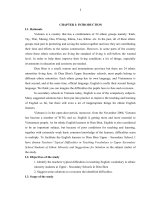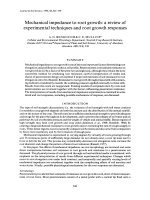Managing projects in organizations how to make the best use of time techniques and people
Bạn đang xem bản rút gọn của tài liệu. Xem và tải ngay bản đầy đủ của tài liệu tại đây (1.03 MB, 279 trang )
Managing Projects
in Organizations
J. Davidson Frame
Q
Managing Projects
in Organizations
How to Make the Best Use of Time,
Techniques, and People
Third Edition
Copyright © 2003 by J. Davidson Frame.
Published by Jossey-Bass
A Wiley Imprint
989 Market Street, San Francisco, CA 94103-1741 www.josseybass.com
No part of this publication may be reproduced, stored in a retrieval system, or transmitted
in any form or by any means, electronic, mechanical, photocopying, recording, scanning, or
otherwise, except as permitted under Section 107 or 108 of the 1976 United States Copyright
Act, without either the prior written permission of the Publisher, or authorization through
payment of the appropriate per-copy fee to the Copyright Clearance Center, Inc., 222
Rosewood Drive, Danvers, MA 01923, 978-750-8400, fax 978-750-4470, or on the web at
www.copyright.com. Requests to the Publisher for permission should be addressed to the
Permissions Department, John Wiley & Sons, Inc., 111 River Street, Hoboken, NJ 07030,
201-748-6011, fax 201-748-6008, e-mail:
Jossey-Bass books and products are available through most bookstores. To contact JosseyBass directly call our Customer Care Department within the U.S. at 800-956-7739, outside
the U.S. at 317-572-3986, or fax 317-572-4002.
Jossey-Bass also publishes its books in a variety of electronic formats. Some content that
appears in print may not be available in electronic books.
Library of Congress Cataloging-in-Publication Data
Frame, J. Davidson.
Managing projects in organizations : how to make the best use of time, techniques,
and people / by J. Davidson Frame.—3rd ed.
p. cm.
Includes bibliographical references and index.
ISBN 0-7879-6831-5 (alk. paper)
1. Project management. I. Title.
HD69.P75F72 2003
658.4'04—dc21
2003014283
Printed in the United States of America
THIRD EDITION
HB Printing 10 9 8 7 6 5 4 3 2 1
The Jossey-Bass
Business & Management Series
Q Contents
Preface
The Author
Introduction: Understanding the Process of
Managing Projects
xi
xix
1
Part One: The Project Context: People, Teams,
and the Organization
1
Operating Within the Realities of Organizational Life
25
2
Finding and Working with Capable People
50
3
Structuring Project Teams and Building Cohesiveness
80
Part Two: Project Customers and Project Requirements
4
Making Certain the Project Is Based on a Clear Need
111
5
Specifying What the Project Should Accomplish
137
Part Three: Project Planning and Control
6
Tools and Techniques for Keeping the Project on Course
163
7
Managing Special Problems and Complex Projects
210
8
Achieving Results: Principles for Success as a
Project Manager
241
References
249
Index
251
ix
To Deborah and Sally
Q Preface
The first edition of Managing Projects in Organizations was published
in 1987. Its entry into the marketplace at that time was propitious, because it coincided with a surging worldwide interest in project management. From the beginning, book sales were respectable. Quite a
few colleges and universities adopted it for use in introductory courses
in project management, and training departments in organizations
such as AT&T, Fannie Mae, and Freddie Mac distributed it to employees who were studying project management topics.
The second edition was published in 1995. Although the fundamental premises of project management had not changed since the
book first came out, new developments in the business arena altered
the business environment sufficiently that the book’s contents needed
to be adjusted to reflect the new conditions. For example, the explosive growth of Total Quality Management in the late 1980s and early
1990s put customers at center stage of all business activity. My copious references to “end users” in the first edition seemed too limiting
in the new environment. In the second edition, I broadened my approach to address the concerns of all customers, not just end users.
Time marches on, and it became necessary to issue this newest edition of Managing Projects in Organizations. Of particular note has
been the growing influence of the Project Management Institute
(PMI) as the world’s standard-setting body in project management.
In 1996 and again in 2000, PMI made revisions to its A Guide to the
Project Management Body of Knowledge, known best by its acronym,
PMBOK (PMI, 1996, 2000). In these revisions, PMI took major steps
toward updating world standards on project management practice.
For example, over the years, there has been substantial confusion
about how work breakdown structures (WBSs) should be developed.
One approach was to focus on product-oriented WBSs and the other
on task-oriented WBSs. PMI finally resolved this issue in 2001 when
it published PMI Practice Standard for Work Breakdown Structures
xi
xii
PREFACE
(PMI, 2001) and suggested that WBSs could contain both product and
task elements.
Another example: Many business enterprises were reluctant to
adopt the important earned-value approach to integrated cost and
schedule control because they saw this method as too arcane. It originated in the military and employed unfriendly terminology that was
difficult to comprehend. Beginning in the mid-1990s and continuing
through today, the earned-value community has made some changes
to earned-value processes and vocabulary to make this method more
accessible to ordinary businesses.
This third edition of Managing Projects in Organizations has been
updated to accommodate changes in the business environment and
project management practices that have arisen since 1995. In addition
to the changes already noted, the book has new material on establishing a project office, managing project portfolios, and managing virtual teams.
INTENDED AUDIENCE
Let the reader beware! Managing Projects in Organizations is designed
to be an introduction to project management. It is written to provide
readers with a fairly quick and painless overview of key issues. I recently received a copy of a project management textbook by a prominent author. It is more than one thousand pages long! I suspect that
novices would take one look at this book and conclude that project management is an arcane discipline best left to engineers with
plenty of technical training. In my opinion, that conclusion would be
incorrect.
This book is written for information age workers searching for a
way to get a handle on the projects they have been assigned to run. I
am talking here about office workers, educators, information systems
managers, R&D personnel, lawyers, writers, budgeters, and the vast
number of other people whose work causes them to manipulate
information rather than tangible things. It is likely that these individuals have drifted into positions of responsibility as a natural outgrowth of their routine activities. By showing some degree of initiative
and organizational ability in carrying out their daily tasks, they find
one day that they have been given responsibility for carrying out a
project.
Preface
xiii
PROJECT MANAGEMENT AS THE
ACCIDENTAL PROFESSION
Project management has been called the accidental profession. It is accidental in at least two senses. First, until quite recently, it has not been
a profession that people have consciously chosen to pursue. No child
answers the question, “What do you want to be when you grow up?”
with the answer, “Why, a project manager, of course!” People typically
become project managers after stumbling onto project management
responsibilities.
Project management is an accidental profession in a second sense
as well: knowledge of how to run projects often is not acquired
through systematic inquiry but is gained in a hit-or-miss fashion. Having received little or no formal preparation for their jobs, typical project managers set out to reinvent the fundamental precepts of project
management. Frequently, their trial-and-error efforts result in costly
mistakes. If novice project managers are good at their jobs, they chalk
up these mistakes to experience and avoid them in the future. After
five to ten years of this process, the novice (if he or she has survived
this long) graduates to the status of seasoned professional.
Great strides have been made in recent years to reduce the level of
accident in our projects. Beginning in the late 1980s, key decision
makers in organizations began to realize that the project management
approach could offer them significant help in achieving results in
chaotic times. To diminish the level of accident in managing projects,
organizations began requiring their employees to learn project management skills more systematically.
Today, many companies are working diligently to improve their
project management competencies. Interestingly, this new commitment to project management excellence is occurring in a wide array
of industries. Some are traditional project-focused industries, such as
construction, aerospace, and defense. But most of the commitment
seems to be coming from nontraditional information age industries,
such as telecommunications, computer systems, banking, insurance,
and pharmaceuticals.
Commitment to upgrading project management skills is not solely
a North American concern. East Asian, European, Middle Eastern, and
Latin American organizations are now putting their employees
through project management training programs and encouraging
xiv
PREFACE
them to become certified Project Management Professionals through
the certification program of the Project Management Institute.
MY EXPERIENCES
I have worked with information age projects all my adult life. As an
undergraduate and graduate student, I was immersed in informationbased projects for homework assignments, computer programming,
term papers, and finally my doctoral dissertation. In industry, I was a
full-time project manager for seven years, running about twenty-five
archetypical information age projects. Most of them involved the design of scientific research evaluation systems, software development,
office automation, and the writing of technical reports. Like 99 percent of my colleagues, I learned project management on the job. In
1979, I left industry for academia, and since then I have been teaching graduate courses on project management.
Since 1983, I have also been conducting seminars on the management of information age projects. About thirty thousand experienced
project managers have taken these seminars. My family refers to them
as my road show, since they are held in different cities throughout the
world. I first took my road show abroad in the summer of 1985, when
I carried it to China, where I frequently return with my project management courses. I have also delivered seminars in Hong Kong, Singapore, Taiwan, Thailand, Australia, Argentina, Brazil, Korea, France,
Germany, Great Britain, Spain, Finland, Poland, South Africa, and
Canada. It is comforting to see that Murphy’s Law is as alive abroad
as in the United States.
CONTENTS OF THE BOOK
My experiences as both a practicing project manager and a teacher
have led me to conclude that what information age project professionals want and need is a practical and flexible approach to managing
their projects. This book is designed to give them such an approach.
It recognizes that many of the commonly employed tools used on traditional projects are of limited utility to information age knowledge
workers. It shows how the traditional tools, with some modification,
can be usefully employed on these projects. It also offers insights into
new tools that are emerging and are ideally suited for application on
information age projects. Readers interested in a more advanced treat-
Preface
xv
ment of project management might want to investigate my recently
published work, The New Project Management (2002).
The Introduction to Managing Projects in Organizations provides
a broad overview of what project management is about. It defines
terms and describes the stages of the project life cycle. I focus special
attention on two key lessons that the book emphasizes: avoiding pitfalls and making things happen.
Part One, encompassing the first three chapters, addresses the overall project context, encompassing people, teams, and the organization.
The first two chapters examine projects in their organizational context. Chapter One examines how organizational issues can lead to
project success or failure. One of the principal organizational realities
that project managers face is lack of authority to control directly the
resources necessary for carrying out a project. Another is the central
importance of politics in projects. The first chapter offers strategies
for coping with these and other realities.
Chapter Two shows how project managers can improve their managerial efficacy by paying more attention to the people involved in
projects. The most difficult aspect of project management is the management of human resources. When managers develop a knack for
dealing with project staff, bosses, vendors, and fellow managers who
control needed resources, they increase immeasurably the likelihood
of project success.
The relationship between team structure and effective project management is the topic of Chapter Three. A major goal of good project
managers is to fashion effective teams in environments that are inherently inimical to team building. This chapter offers pointers on
how managers can improve the chances of a project’s success by selecting a team structure that strengthens team efficiency. Special attention is directed to four team structures that seem particularly
effective in projects: isomorphic, specialty, egoless, and surgical teams.
Part One thus focuses on projects from the perspective of organizational issues. Part Two, consisting of Chapters Four and Five, casts
light on the interrelated topics of needs and requirements analysis. Although everyone acknowledges that cost and schedule overruns are
bad, a little reflection suggests that a more serious failing is providing
customers with deliverables that are underused, misused, or not used
at all. If we define project failure in this way, then it becomes clear that
an enormous fraction of the projects undertaken are in some sense
failures.
xvi
PREFACE
Why are so many project deliverables not well used? Often because
customer needs have not been met or the requirements are poorly specified. Chapter Four offers ways to improve identification of customer
needs (for example, by building a needs hierarchy), and Chapter Five
provides suggestions on defining requirements more effectively (for example, by employing the application prototyping methodology).
Part Three looks at a third pitfall in the management of projects,
poor planning and control, and then ties together the many components of project management. Chapter Six describes the standard tools
used for enhancing planning and control—for example, work breakdown structures, Gantt charts, precedence diagram method networks,
resource loading charts, and resource spreadsheets. Chapter Seven discusses special planning and control topics that are not usually covered
in conventional project management texts: planning and control of
multiple-project portfolios, very large projects, projects that are carried out under contract, and projects carried out by virtual teams.
Planning and control tools that are infrequently discussed—such as
the earned-value approach, gap analysis, and the schedule milestone
review technique—are also investigated here. Finally, this chapter addresses what became a hot topic in the late 1990s and continues to be
important today: how to establish and maintain a project office. Chapter Eight then brings together the different pieces into a cohesive
whole.
Good tools make the job of project manager easier, but the tools
by themselves will not ensure success—or even mediocre performance. Going beyond a mere litany of project management techniques, this book offers an overall methodology for dealing with
information age projects. It emphasizes seeing projects in their organizational context and stresses doing things right at the earliest stages
to minimize the inevitable grief of having to do them over again later.
When projects are carried out nicely and chaos is converted into
order, project managers justifiably feel as high as kites, denizens of a
heaven of sorts that is reserved for the supercompetent. When projects go wrong, they can be like hell on earth. I hope that this book will
help project managers affix the wings that will enable them to reach
the heights. But as experienced project managers, we are always looking over our shoulders, always aware of the ever-present law of Murphy. Let’s aim for the heights . . . but remember Icarus, remember
Lucifer.
Preface
xvii
ACKNOWLEDGMENTS
Writing books is a solitary undertaking, but every now and then, the
solitude is punctuated with significant inputs from the outside. Without doubt, the greatest stimulus to my writing comes from my students in academic and corporate classrooms. They apprise me of the
latest developments in their organizations, enabling me to gain early
insights into issues that enterprises are facing and solutions they are
implementing to deal with the issues. They also keep me on my toes
as I test new ideas on them. If my ideas are without merit, they let me
know, so I find myself continually humbled in the classroom.
Special thanks go to my editor at Jossey-Bass, Kathe Sweeney, who
served as a sounding board for my ideas. Finally, thanks to my immediate family, Yanping, Katy, and Lele, who put up with me cheerfully
when I get grouchy at the writing table.
Arlington, Virginia
July 2003
J. Davidson Frame
Q The Author
J. Davidson Frame is academic dean at the University of Management
and Technology (UMT), where he runs graduate programs in project
management. Prior to joining the UMT faculty in 1998, he was on the
faculty of the George Washington University. In that capacity, he established the university’s project management program and served as
chairman of the Management Science Department and director of the
Program on Science, Technology, and Innovation. Since 1990, he has
also served as director of the Project Management Certification Program and director of Educational Services at the Project Management
Institute. Before entering academia in 1979, he was vice president of
Computer Horizons and manager of its Washington, D.C., office.
While there, he managed more than two dozen information age projects. Since 1983, he has conducted project management and risk management seminars throughout the United States and abroad. About
thirty thousand professionals have attended these seminars.
Frame earned his B.A. at the College of Wooster and his M.A. and
Ph.D. in international relations at the American University, focusing primarily on econometrics and economic development. He has written
more than forty articles and seven books, including The New Project
Management (second edition, Jossey-Bass, 2002), Project Management
Competence (Jossey-Bass, 1999), and Managing Risk in Organizations
(Jossey-Bass, 2003).
xix
I N T R O D U C T I O N
Understanding
the Process of
Managing Projects
Q
P
eople have been undertaking projects since the earliest days of organized human activity. The hunting parties of our prehistoric forebears were projects, for example; they were temporary
undertakings directed at the goal of obtaining meat for the community. Large, complex projects have also been with us for a long time.
The pyramids, the Great Wall of China, and Hadrian’s Wall were projects that, in their time, were of roughly the same dimensions as the
Manhattan Project to build an atomic bomb or the Apollo Project to
send humans to the moon.
All of us are constantly undertaking projects in our day-to-day
lives. Some common examples are preparing for a picnic, repairing a
leaky faucet, fixing up the house for Aunt Telia’s visit, and writing
a term paper for a class. Projects are an integral part of our lives. Typically, we carry out these projects in a haphazard way. We finally get
around to fixing the faucet when we can no longer tolerate the din of
dripping water, and we begin writing our term paper the day before
it is due. We tell a subordinate in an offhand manner to develop a
marketing plan, and we are upset with him when the completed plan
1
2
MANAGING PROJECTS IN ORGANIZATIONS
in no way looks like what we envisioned. We are given money to investigate the physical properties of a new polymer, but we run out of
cash before we are even half finished.
We are surrounded by projects, we work on them daily, but rarely
do we consciously strive to get a grip on them—to manage them. Although people have been carrying out projects for millennia, project
management as a unique management form is a recent development.
To a large degree, it was a by-product of the major projects of World
War II, the best known being the Manhattan Project. A conscious attempt was made to coordinate its enormous budget, schedule, and resource complexity as efficiently as possible. The Manhattan Project
moved project management from the realm of the accidental to the
domain—at least ideally—of the carefully contrived.
Beginning in the 1990s, project management became a hot management approach. As the U.S. economy entered a postindustrial phase,
American managers discovered that many of the management guidelines established for a manufacturing economy no longer served them
well in an information economy. In a manufacturing environment, emphasis is placed on predictability and repetitive activities, and to a large
extent, management is concerned with standardization and rationalization of production processes. With an information economy, uniqueness of events has replaced repetition. Information itself is dynamic and
ever changing. Flexibility is the watchword of the new order, and project management is a key to this flexibility.
WHAT IS A PROJECT?
We use the term project frequently in our daily conversations. A husband, for example, tells his wife, “My main project for this weekend is
to straighten out the garage.” Going hunting, building pyramids, fixing faucets, and preparing for a picnic share certain features that make
them projects:
• They are goal oriented.
• They involve the coordinated undertaking of interrelated
activities.
• They are of finite duration, with beginnings and ends.
• They are all, to a degree, unique.
Introduction
3
In general, these four characteristics distinguish projects from other
undertakings. Each of these characteristics has important implications, so we should examine them closely.
Goal Orientation
Projects are directed at achieving specific results—that is, they are goal
oriented. These goals drive the project, and all planning and implementation efforts are undertaken so as to achieve them.
Projects are permeated with goals from top to bottom. The principal goal of a computer software project may be to develop a sophisticated database management system. An intermediate goal will be to
test the evolving system to free it from bugs, and a lower-level goal will
be to identify days when project staff are available to attend progress
meetings.
The fact that projects are goal oriented carries with it enormous
implications for their management. For one thing, it suggests that an
important feature of managing projects is to identify relevant goals,
starting at the highest level and then working down to the grassroots.
It also suggests that a project can be viewed as the pursuit of carefully
chosen goals and that progress on the project entails achieving ever
higher levels of goals, until finally we have attained the ultimate goal.
Fortunately for those of us concerned with managing projects, a
whole methodology has been developed over the past few decades to
help us in setting and achieving goals, Management by Objectives
(MBO), and its development occurred independently of the growth
of project management. A solid grasp of the basic principles of MBO
can make a project manager’s life easier.
At its heart, MBO is concerned with two things: establishing clear
objectives (or goals or requirements or milestones) and making sure
that they are achievable. The need for clear objectives cannot be overstated. An objective lacks clarity if, when shown to five people, it is interpreted in multiple ways. Ideally, if an objective is clear, you can show
it to five people who, after reviewing it, hold a single view about its
meaning.
The best way to make an objective clear is to state it in such a way
that it can be verified. This can be done by building in measures in the
statement of objectives. Consider, for example, a coach’s objective that
her star swimmer “swim the pool as fast as possible.” That objective is
4
MANAGING PROJECTS IN ORGANIZATIONS
filled with ambiguity. How fast is “as fast as possible”? Which pool should
the swimmer swim? What stroke is to be employed? By when should the
swimmer be able to achieve the objective? The objective can be strengthened considerably if it is stated as follows: “To be able to swim, by
March 15, four laps of the twenty-five-meter pool, using the freestyle
stroke, in sixty or fewer seconds.” There is still some ambiguity in this
objective (Should the pool be filled with water?), but it clarifies the
coach’s intent quite nicely.
Nevertheless, a clear goal is not enough. It must also be achievable.
The coach’s goal becomes unachievable, for example, if she changes it
to require the swimmer to do the four laps in ten or fewer seconds.
MBO’s solution to establishing realistic goals is to have both the
people who want the work done and the people who are to do the
work develop the goals jointly. Realism is introduced because the people who will do the work have a good sense of what it takes to accomplish a particular job. In addition, this process of goal setting
ensures some measure of commitment on all sides. The need for commitment is dramatized at the end of the goal-setting exercise by having both managers and workers sign an MBO “contract,” in which
management expresses its commitment to supporting the work effort
and workers demonstrate their willingness to do the work.
Four decades of experience with MBO suggest a number of pitfalls
that must be avoided if it is to be implemented effectively. One common problem is that people get bogged down negotiating objectives.
They may spend more time defining what the objectives should be
than actually doing their work. Practitioners of MBO must be vigilant
in reducing the bureaucratic tendencies of goal setters. Another common problem is that during the negotiation of objectives, management subtly imposes its will on the workers, so that the resulting
objectives do not truly reflect the workers’ concerns. In this case, MBO
can be seen to be a threatening exercise and might be resisted by the
workforce.
Coordinated Undertaking
of Interrelated Activities
Projects are inherently complex. They entail carrying out multiple activities that are related to each other in both obvious and subtle ways.
Some tasks cannot be executed until other tasks have been completed,









